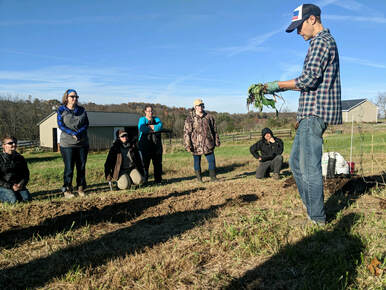 I want to write about the economics of teaching permaculture and how it fits into the larger goal of “living in harmony with nature,” which is what permaculture is all about. In the process I’ll probably ramble a bit about economic theory, but I’ll also share specific figures from my 5 years of teaching experience. As a teacher who wants to see permaculture grow, I think it is important to be open about how and why we teach courses. I’ve been interested in economics as a lense through which to view human interactions with the planet for a long time - and I’ve zigzagged all over the political spectrum. In 7th grade I got seduced by Ayn Rand libertarianism, in high school I rejected capitalism and started reading the Monthly Review, and in college I “saw the light” in liberal economics and the technocratic effort to utilize capitalism for its benefits (efficient allocation of resources) while regulating its negative externalities (pollution, income inequality, etc.). Then, in my mid-twenties, like a lot of millennials, I got jazzed on the idea of socially-responsible entrepreneurship and the triple bottom line (we can have our money and feel good about it too!). In the past few years, as I’ve gotten married, racked up medical debt, bought land, and had a baby, my main focus has shifted to building economic stability for my family. I’ve been forced to accept, for better and for worse, our current economic context and figure out how to create resiliency within it. That means I get stoked about things like health insurance and matching retirement funds instead of the ideas of Keynes and Hayek. Don’t get me wrong, I am still interested in designing a path towards a better system, it’s just that my priorities have shifted - call me a realist with big dreams. Enter permaculture design and the side hustle of teaching… I got into permaculture to learn how to design thriving human habitats that increase the health of the planet. At age 25, a few years out of college, I spent $1,200 to get my Permaculture Design Certificate. Compared to the cost of my undergraduate degree it was a small educational investment, although it was about half of my savings at the time. That investment launched my permaculture journey and a few years later I found myself as a teaching apprentice. At that point the only motivation to teach was Bill Mollison’s directive of “each one, teach one” - to spread the gospel that I thought could save the world. Fast forward another few years and I now co-own a permaculture education business along with Emilie Tweardy and Ryan Blosser. The teaching impetus is still the same, but now I have to make a certain amount per course to pay the business expenses and to justify spending time doing the work instead of being at home with the family. Here is a little breakdown of the finances for the average SPI PDC, to put things into context: Revenue Cost Per Student: $1000 # of Students: 15 Course Revenue: $15,000 Expenses: Administration overhead ((taxes, licensing, insurance, accounting) - $2,250 Guest Teacher Fees: $2,500 Teacher Apprentice Fee: $200 Supplies and Food: $500 Space Rental: Donated by SPI Teaching Team Course Coordinator Fee - 18% revenue: $2,700 Total Expenses: $8,150 Lead Teacher Hours: Prep Hours: 50 Teaching Hours: 90 Profit Course Profit: $6,850 Take-Home Profit Per Lead Teacher: $2,283 Average Hourly Wage Per Lead Teacher (before taxes) = $16.28 As you can see, I make about $2,000 per course once you factor in income and self-employment taxes, and each course is a 4-weekend commitment, plus planning time. If we teach 2 courses in a year that is about $4,000 in supplemental income for my family - not an insignificant amount but also not exactly a game changer. This works for us right now, but I know that if I were to make much less I couldn’t justify it, even though I love doing it. So there it is, our current money-based financial teaching model. Obviously, there are pros and cons to this model. What I like about it is that the monetary model incentivizes teachers to work hard, be accountable and professional, and provide a good product. It also provides clear feedback in the form of enrollment numbers - if we aren’t serving our customers we will find out quickly. Incentivizing people to work hard is one of the biggest benefits of the market mechanism from my experience, especially in team projects - have you ever worked with a group of unpaid volunteers and tried to get action items completed thoroughly and on time? There are also some things I don’t like about our model, the biggest one being inaccessibility. Afterall, only a certain percentage of people are in a position where they can spend $1,000 and 4 weekends on a class. The other drawback to the monetary model is that it can be tempting for a teacher to pump out courses just to make cash. I never want to get so wrapped up in the lucrativeness of teaching that I stop doing the actual work of permaculture - developing my farm and building my community in harmony with nature. There are certainly other models for teaching out there and we have and will continue to explore them. We could teach informal free courses and avoid all of the costs of licensing, taxes, accounting, etc. We could go digital like Geoff Lawton, drastically decreasing our overhead and tuition while reaching more students. Both options would decrease the quality of our courses in different ways. We could also start taking other forms of capital as payment for our courses (see Ryan’s blog series on Time Banks and the 8 Forms of Capital). We’ve tried scholarships and a sliding-scale, but we’ve found that neither is an effective way of making the course accessible to students in true financial need. It’s so difficult to come up with a way to measure need that we’ve found no significant difference in socioeconomic position between our students who take advantage of the tuition discounts and those who don’t. So, for now, we’ve settled for an early bird discount and the option of a tuition payment plan as ways of helping those with limited financial resources. Our current model isn’t perfect, but it is working as a way to spread the powerful and much-needed idea of permaculture. And that’s the key for me: it has to work, or else we’re not doing anyone any good. So, for now, we utilize this tool called money while keeping our greater goals in mind, moving forward, and always being open to feedback and change.
2 Comments
Kilt
5/11/2019 09:54:15 pm
Thank you for an honest reflection on the teacher/supplier-side of providing PDCs.
Reply
4/7/2020 11:26:05 am
Great to see the honest integrity of the permaculture community, as opposed to the recurring deceptions of the current industrial agriculture system.
Reply
Leave a Reply. |
Authors
Daniel Firth Griffith Archives
June 2022
Categories |
Proudly powered by Weebly

 RSS Feed
RSS Feed